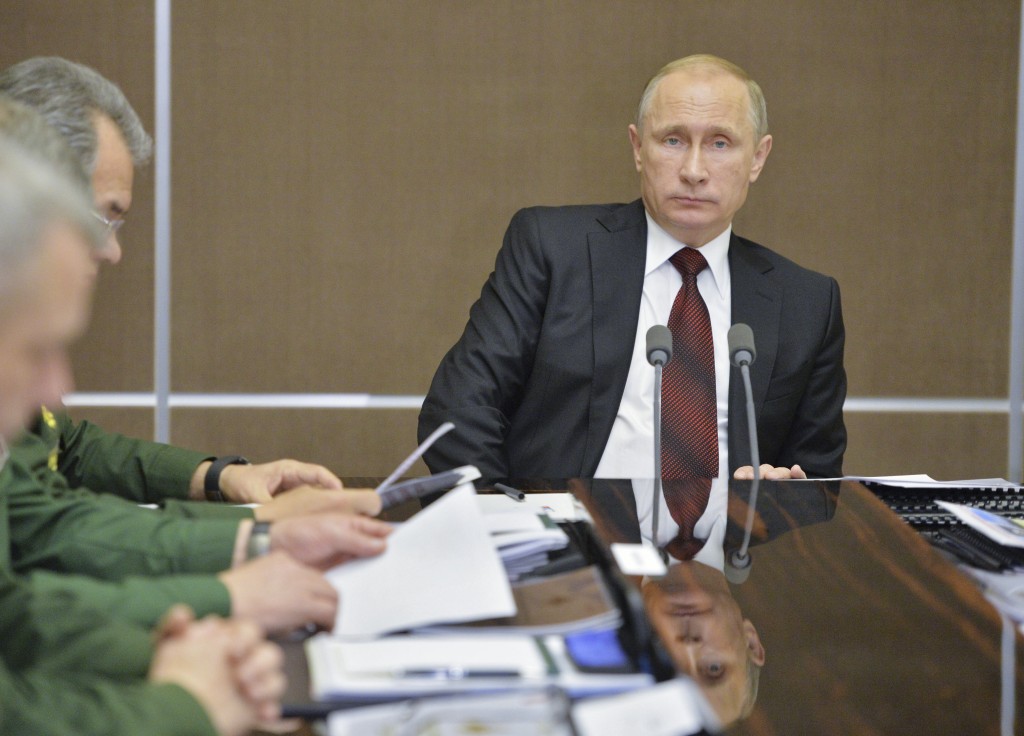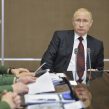
Now You See It, Now You Don’t: Putin Cheating on the Armistice Line in Ukraine
Publication: Eurasia Daily Monitor Volume: 12 Issue: 18
By:

Russian President Vladimir Putin is playing a cheating game with the West and Ukraine, not only hollowing out the Minsk armistice agreements (see EDM, January 22, 23, 27), but even shifting the agreed-upon demarcation line on the ground and on the map. Kyiv is alert to Putin’s con games, but it is forced to face a stronger Russia one-on-one, without Western assistance. Ukraine’s Western partners are slow, as usual, to notice Putin’s maneuvers, most recently at the January 21 “Normandy group” meeting in Berlin. There, Russia’s Foreign Affairs Minister Sergei Lavrov prevailed on his German and French counterparts to evenhandedly urge “all signatories of the Minsk agreements to meet in the coming days to implement the ceasefire and the withdrawal of heavy weapons in accordance with the Line of Contact as agreed in Minsk on September 19 [2014]” (Auswaertiges-amt.de, January 21).
But, which Line of Contact exactly? Lavrov brought Putin’s new version of the Line of Contact (demarcation line) to the Berlin meeting. The German and French ministers did not seem to object to the deceptive new version. And what does “signatory” mean in Russia’s case? Russia is a party to the conflict in every real sense, but only a party to the armistice in an official sense, rejecting its obligations as a signatory. Moscow is, instead, using its signatory’s status to protect the Donetsk and Luhansk “people’s republics” on the ground.
Putin first revealed his new version of the demarcation line in a January 15 letter to Ukrainian President Petro Poroshenko. The Kremlin released only bits of that document, with misleading follow-up comments on a daily basis. Citing Putin’s letter, Russia justified its proxies’ attacks against Ukraine along the entire demarcation line. The Ukrainian government did not manage to explain the facts fully, even after a Kyiv journal did so on January 23 (see below). The Russian offensive operations persist, and Putin’s letter remains un-debunked outside the target country Ukraine.
The full text of Putin’s letter circulated inside Ukrainian government circles from January 16. The Russian president called on Ukraine and the Donetsk and Luhansk “people’s republics” (dignified as “DPR” and “LPR,” in the document) to withdraw their respective heavy artillery and missile systems by 15 kilometers on either side of the demarcation line, in accordance with the September 19, 2014, Minsk Memorandum (armistice document, still unimplemented). That document does stipulate this disengagement measure, referencing a then-existing demarcation line, with minor agreed-upon mutual adjustments.
Putin’s letter, however, shifts the demarcation line. He introduces the “de facto demarcation line, in existence as of January 13, 2015 [starting date of the latest Russian offensive].” This new de facto line incorporates at least 550 square kilometers of ground captured by Russia’s proxies, westward of the Minsk demarcation line. It also incorporates a portion of the “demilitarized zone” that the Minsk agreement had created on the approaches to Mariupil. Since then, however Russian and proxy forces have entered that zone (the January 13 missile strike at Volnovakha, opening shot in the latest Russian offensive, came from one part of that violated zone, as did the January 24 missile strike on Mariupil).
Maximizing the ambiguities, Putin’s letter called for the reciprocal disengagement of forces along “the line of contact of September 19, 2014 and [sic] of January 13, 2015.” An accompanying map showed both lines, indirectly highlighting the shift in favor of the Russian side. Furthermore, “We [Russia] together with the OSCE [Organization for Security and Cooperation in Europe] shall organize the monitoring over the execution of these measures.”
The intentions behind Putin’s letter are clear. First, to push Ukraine into, itself, departing from the terms of the September 19 Minsk agreements, so as to make it even more difficult for Kyiv to invoke the protection of those agreements. Second, to legitimize the shift in the demarcation lines by Russian and proxy forces to more advanced positions. Third, to open access for the Russian military to “monitor” the Ukrainian lines, without reciprocal access for Ukrainians to monitor the other side. And fourth, to cast Russia in the role of monitoring the disengagement and the new demarcation line—a role that Russia could subsequently try to build into a “peacekeeper’” role (with a subservient OSCE as a cover).
In a series of follow-up statements, Russian diplomacy announced that it was successfully “using its influence upon the ‘DPR’ and ‘LPR’ to agree with these measures” (Interfax, January 22–27). Had the German and French ministers not asked Russia to “use its influence” in that way? What more could they ask?
The September 19 Minsk agreement includes a secret annex, defining the demarcation line in technical details, along with specifications on the reciprocal withdrawal of heavy artillery and missile systems. The agreement itself was made public by the OSCE (Osce.org, September 20, 2014), but without the secret annex. The influential Kyiv journal Dzerkalo Tyzhnia (Zerkalo Nedeli) disclosed the full documents and relevant maps in its January 23 issue.
President Petro Poroshenko and the Ukrainian government take the position that Ukraine will continue adhering to the Minsk armistice agreement. Kyiv will not join Russia in bypassing and devaluing that agreement. One lesson learned is that all agreements with Russia must be made public, for Ukraine’s own protection against predictable Russian deceptions. Meanwhile, Russian and proxy forces look set to intensify military pressures, aiming to compel Kyiv into re-negotiating the armistice terms to its own detriment.




